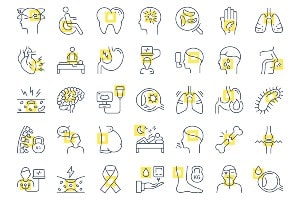About Shin Splints

Learn about the disease, illness and/or condition Shin Splints including: symptoms, causes, treatments, contraindications and conditions at ClusterMed.info.
Shin Splints

| Shin Splints |
|---|
Shin Splints InformationShin splints facts
Can shin splints be prevented?To the extent that shin splints are an overuse injury, shin splints can be prevented by gradually increasing exercise activities. Proper footwear can also help to prevent shin splints. How are shin splints diagnosed?The diagnosis of shin splints is usually made during physical examination. It depends upon a careful review of the patient's history and a focused physical exam (on the examination of the shins and legs where local tenderness is noted). Specialized (and costly) tests (for example, bone scans) are generally only necessary if the diagnosis is unclear. Radiology tests, such as X-rays, bone scan, or MRI scan, can be helpful in this setting to detect stress fracture of the tibia bone. What are risk factors for shin splints?Risk factors for shin splints include running and over-training on hills, inadequate footwear for athletic activity, and poor biomechanics of the design of the legs and feet. What are shin splints symptoms?Shin splints cause pain in the front of the outer leg below the knee. The pain of shin splints is characteristically located on the outer edge of the mid region of the leg next to the shinbone (tibia). An area of discomfort measuring 4-6 inches (10-15 cm) in length is frequently present. Pain is often noted at the early portion of the workout, then lessens, only to reappear near the end of the training session. Shin splint discomfort is often described as dull at first. However, with continuing trauma, the pain can become so extreme as to cause the athlete to stop workouts altogether. What are shin splints?Shin splints are injuries to the front of the outer leg. While the exact injury is not known, shin splints seem to result from inflammation due to injury of the soft tissues in the front of the outer leg. Shin splints are a member of a group of injuries called overuse injuries. Shin splints occur most commonly in runners or aggressive walkers. What causes shin splints?A primary culprit causing shin splints is a sudden increase in distance or intensity of a workout schedule. This increase in muscle work can be associated with inflammation of the lower leg muscles, those muscles used in lifting the foot (the motion during which the foot pivots toward the tibia). Such a situation can be aggravated by a tendency to pronate the foot (roll it excessively inward onto the arch). Similarly, a tight Achilles tendon or weak ankle muscles are also often implicated in the development of shin splints. What is the multifaceted relative rest approach?The following steps are part of the multifaceted approach:
What is the prognosis (outlook) for shin splints?The extent of injury that occurs prior to any rehabilitation program plays a significant role in determining the time frame necessary for complete recovery. Generally, the outlook is excellent for full recovery, but physical therapy treatment can be necessary. What is the treatment for shin splints?Previously, two different treatment management strategies were used: total rest or a "run through it" approach. The total rest was often an unacceptable option to the athlete. The run through it approach was even worse. It often led to worsening of the injury and of the symptoms. Currently, a multifaceted approach of relative rest is successfully utilized to restore the athlete to a pain-free level of competition. |
More Diseases
A | B | C | D | E | F | G | H | I | J | K | L | M | N | O | P | Q | R | S | T | U | V | W | X | Y | Z
Diseases & Illnesses Definitions Of The Day
- Photodynamic Therapy ‐ Am I a good candidate for photodynamic therapy?, Does PDT make me permanently more sensitive to light? …
- Miliaria Profunda (Heat Rash) ‐
- Sociopathic Personality Disorder (Antisocial Personality Disorder) ‐ Antisocial personality disorder (APD or ASPD) facts, What are antisocial personality disorder symptoms and signs? …
- TB (Tuberculosis (TB) Facts) ‐ Are there different types of tuberculosis (TB)?, How can people prevent tuberculosis? …
- Clicking in the Ear (Tinnitus (Ringing in the Ears)) ‐ Can tinnitus be prevented?, Does acupuncture treat tinnitus symptoms? …
- Nail Fungus (Fungal Nails) ‐
- Sunburn and Sun Poisoning ‐ Are there any home remedies to treat sunburn?, Can antioxidants protect against sunburn? …
- Poison Control Centers ‐ Emergency poison information, Has the person collapsed or stopped breathing? …
- Toothache Overview ‐ Are home remedies effective for a toothache?, How is a toothache diagnosed? …
- Follicular Carcinoma (Thyroid Cancer) ‐ Chemotherapy, How do health care professionals diagnose thyroid cancer? …